stop start DODGE SPRINTER 2007 2.G Owners Manual
[x] Cancel search | Manufacturer: DODGE, Model Year: 2007, Model line: SPRINTER, Model: DODGE SPRINTER 2007 2.GPages: 393, PDF Size: 7.61 MB
Page 116 of 393
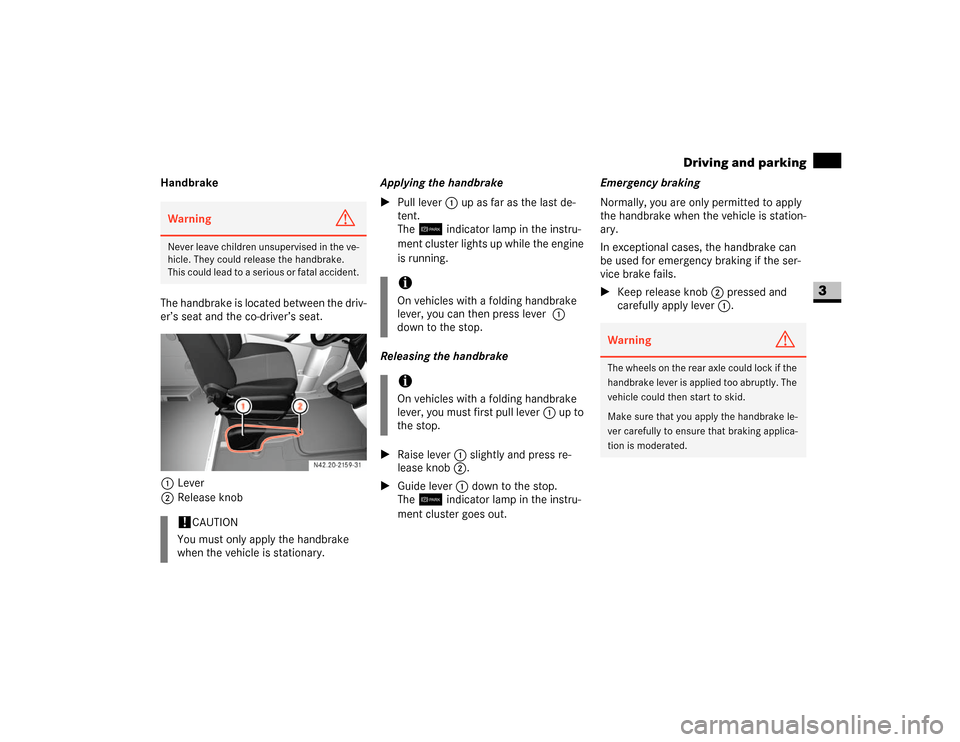
115 Controls in detail
Driving and parking
3
Handbrake
The handbrake is located between the driv-
er’s seat and the co-driver’s seat.
1Lever
2Release knobApplying the handbrake
\1Pull lever1 up as far as the last de-
tent.
The7 indicator lamp in the instru-
ment cluster lights up while the engine
is running.
Releasing the handbrake
\1Raise lever1 slightly and press re-
lease knob2.
\1Guide lever1 down to the stop.
The7 indicator lamp in the instru-
ment cluster goes out.Emergency braking
Normally, you are only permitted to apply
the handbrake when the vehicle is station-
ary.
In exceptional cases, the handbrake can
be used for emergency braking if the ser-
vice brake fails.
\1Keep release knob2 pressed and
carefully apply lever1.Warning
G
Never leave children unsupervised in the ve-
hicle. They could release the handbrake.
This could lead to a serious or fatal accident.!
CAUTION
You must only apply the handbrake
when the vehicle is stationary.
iOn vehicles with a folding handbrake
lever, you can then press lever1
down to the stop.iOn vehicles with a folding handbrake
lever, you must first pull lever1 up to
the stop.
Warning
G
The wheels on the rear axle could lock if the
handbrake lever is applied too abruptly. The
vehicle could then start to skid.
Make sure that you apply the handbrake le-
ver carefully to ensure that braking applica-
tion is moderated.
Page 187 of 393
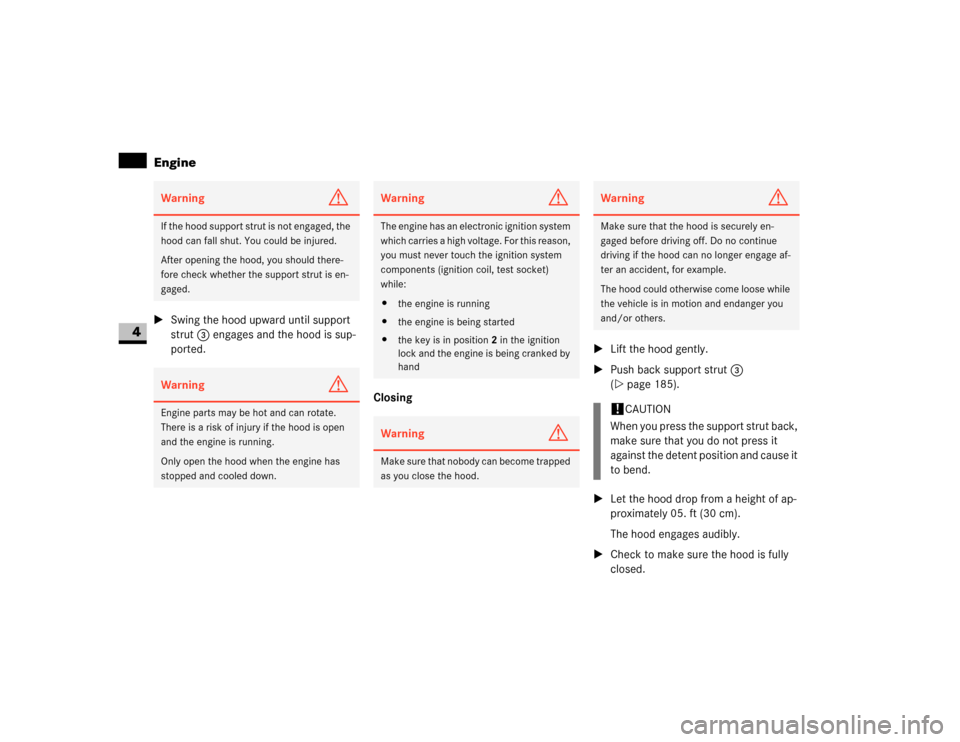
186 OperationEngine
4
\1Swing the hood upward until support
strut3 engages and the hood is sup-
ported.
Closing\1Lift the hood gently.
\1Push back support strut3
(\2page 185).
\1Let the hood drop from a height of ap-
proximately 05. ft (30 cm).
The hood engages audibly.
\1Check to make sure the hood is fully
closed.Warning
G
If the hood support strut is not engaged, the
hood can fall shut. You could be injured.
After opening the hood, you should there-
fore check whether the support strut is en-
gaged.Warning
G
Engine parts may be hot and can rotate.
There is a risk of injury if the hood is open
and the engine is running.
Only open the hood when the engine has
stopped and cooled down.
Warning
G
The engine has an electronic ignition system
which carries a high voltage. For this reason,
you must never touch the ignition system
components (ignition coil, test socket)
while:
\4the engine is running
\4the engine is being started
\4the key is in position2 in the ignition
lock and the engine is being cranked by
handWarning
G
Make sure that nobody can become trapped
as you close the hood.
Warning
G
Make sure that the hood is securely en-
gaged before driving off. Do no continue
driving if the hood can no longer engage af-
ter an accident, for example.
The hood could otherwise come loose while
the vehicle is in motion and endanger you
and/or others.!
CAUTION
When you press the support strut back,
make sure that you do not press it
against the detent position and cause it
to bend.
Page 216 of 393
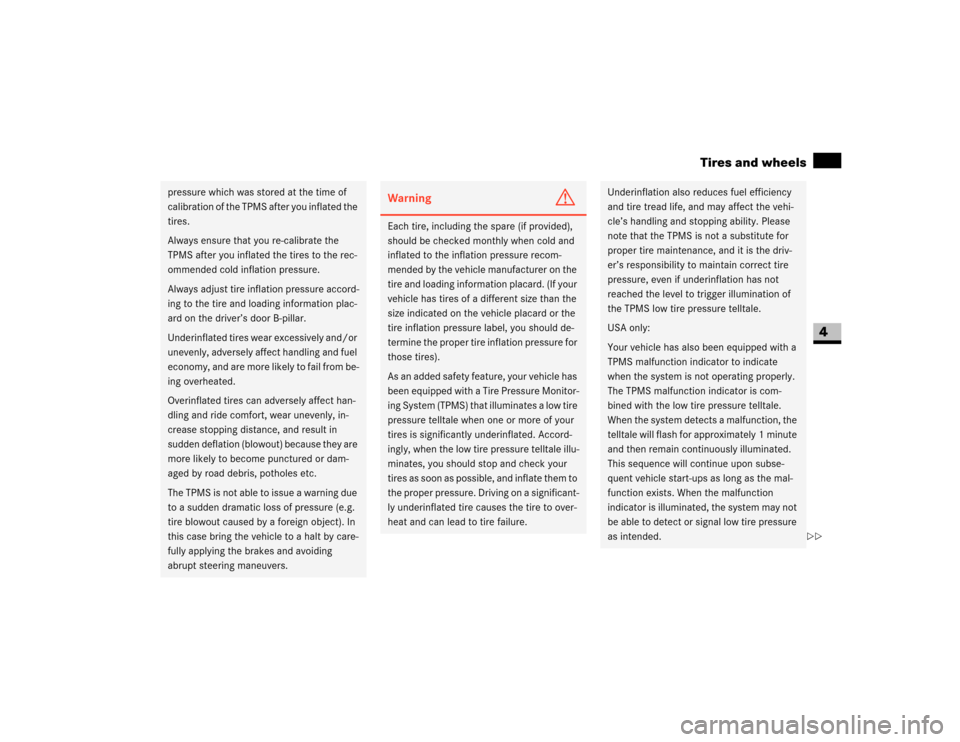
215 Operation
Tires and wheels
4
pressure which was stored at the time of
calibration of the TPMS after you inflated the
tires.
Always ensure that you re-calibrate the
TPMS after you inflated the tires to the rec-
ommended cold inflation pressure.
Always adjust tire inflation pressure accord-
ing to the tire and loading information plac-
ard on the driver’s door B-pillar.
Underinflated tires wear excessively and/or
unevenly, adversely affect handling and fuel
economy, and are more likely to fail from be-
ing overheated.
Overinflated tires can adversely affect han-
dling and ride comfort, wear unevenly, in-
crease stopping distance, and result in
sudden deflation (blowout) because they are
more likely to become punctured or dam-
aged by road debris, potholes etc.
The TPMS is not able to issue a warning due
to a sudden dramatic loss of pressure (e.g.
tire blowout caused by a foreign object). In
this case bring the vehicle to a halt by care-
fully applying the brakes and avoiding
abrupt steering maneuvers.
Warning
G
Each tire, including the spare (if provided),
should be checked monthly when cold and
inflated to the inflation pressure recom-
mended by the vehicle manufacturer on the
tire and loading information placard. (If your
vehicle has tires of a different size than the
size indicated on the vehicle placard or the
tire inflation pressure label, you should de-
termine the proper tire inflation pressure for
those tires).
As an added safety feature, your vehicle has
been equipped with a Tire Pressure Monitor-
ing System (TPMS) that illuminates a low tire
pressure telltale when one or more of your
tires is significantly underinflated. Accord-
ingly, when the low tire pressure telltale illu-
minates, you should stop and check your
tires as soon as possible, and inflate them to
the proper pressure. Driving on a significant-
ly underinflated tire causes the tire to over-
heat and can lead to tire failure.
Underinflation also reduces fuel efficiency
and tire tread life, and may affect the vehi-
cle’s handling and stopping ability. Please
note that the TPMS is not a substitute for
proper tire maintenance, and it is the driv-
er’s responsibility to maintain correct tire
pressure, even if underinflation has not
reached the level to trigger illumination of
the TPMS low tire pressure telltale.
USA only:
Your vehicle has also been equipped with a
TPMS malfunction indicator to indicate
when the system is not operating properly.
The TPMS malfunction indicator is com-
bined with the low tire pressure telltale.
When the system detects a malfunction, the
telltale will flash for approximately 1 minute
and then remain continuously illuminated.
This sequence will continue upon subse-
quent vehicle start-ups as long as the mal-
function exists. When the malfunction
indicator is illuminated, the system may not
be able to detect or signal low tire pressure
as intended.
\2\2
Page 220 of 393
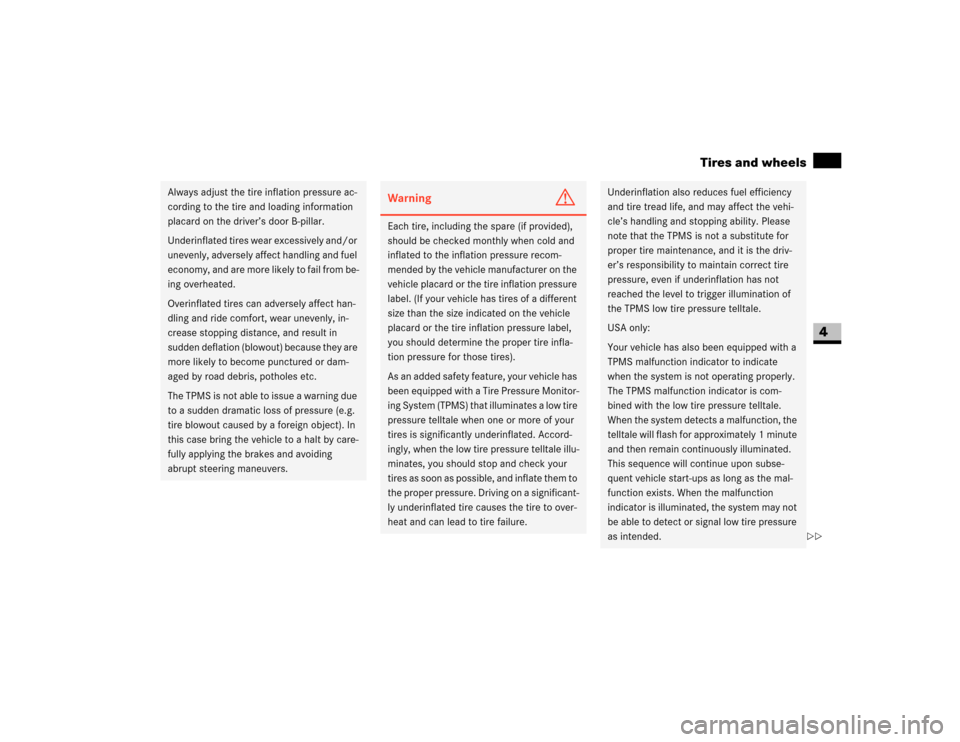
219 Operation
Tires and wheels
4
Always adjust the tire inflation pressure ac-
cording to the tire and loading information
placard on the driver’s door B-pillar.
Underinflated tires wear excessively and/or
unevenly, adversely affect handling and fuel
economy, and are more likely to fail from be-
ing overheated.
Overinflated tires can adversely affect han-
dling and ride comfort, wear unevenly, in-
crease stopping distance, and result in
sudden deflation (blowout) because they are
more likely to become punctured or dam-
aged by road debris, potholes etc.
The TPMS is not able to issue a warning due
to a sudden dramatic loss of pressure (e.g.
tire blowout caused by a foreign object). In
this case bring the vehicle to a halt by care-
fully applying the brakes and avoiding
abrupt steering maneuvers.
Warning
G
Each tire, including the spare (if provided),
should be checked monthly when cold and
inflated to the inflation pressure recom-
mended by the vehicle manufacturer on the
vehicle placard or the tire inflation pressure
label. (If your vehicle has tires of a different
size than the size indicated on the vehicle
placard or the tire inflation pressure label,
you should determine the proper tire infla-
tion pressure for those tires).
As an added safety feature, your vehicle has
been equipped with a Tire Pressure Monitor-
ing System (TPMS) that illuminates a low tire
pressure telltale when one or more of your
tires is significantly underinflated. Accord-
ingly, when the low tire pressure telltale illu-
minates, you should stop and check your
tires as soon as possible, and inflate them to
the proper pressure. Driving on a significant-
ly underinflated tire causes the tire to over-
heat and can lead to tire failure.
Underinflation also reduces fuel efficiency
and tire tread life, and may affect the vehi-
cle’s handling and stopping ability. Please
note that the TPMS is not a substitute for
proper tire maintenance, and it is the driv-
er’s responsibility to maintain correct tire
pressure, even if underinflation has not
reached the level to trigger illumination of
the TPMS low tire pressure telltale.
USA only:
Your vehicle has also been equipped with a
TPMS malfunction indicator to indicate
when the system is not operating properly.
The TPMS malfunction indicator is com-
bined with the low tire pressure telltale.
When the system detects a malfunction, the
telltale will flash for approximately 1 minute
and then remain continuously illuminated.
This sequence will continue upon subse-
quent vehicle start-ups as long as the mal-
function exists. When the malfunction
indicator is illuminated, the system may not
be able to detect or signal low tire pressure
as intended.
\2\2
Page 257 of 393
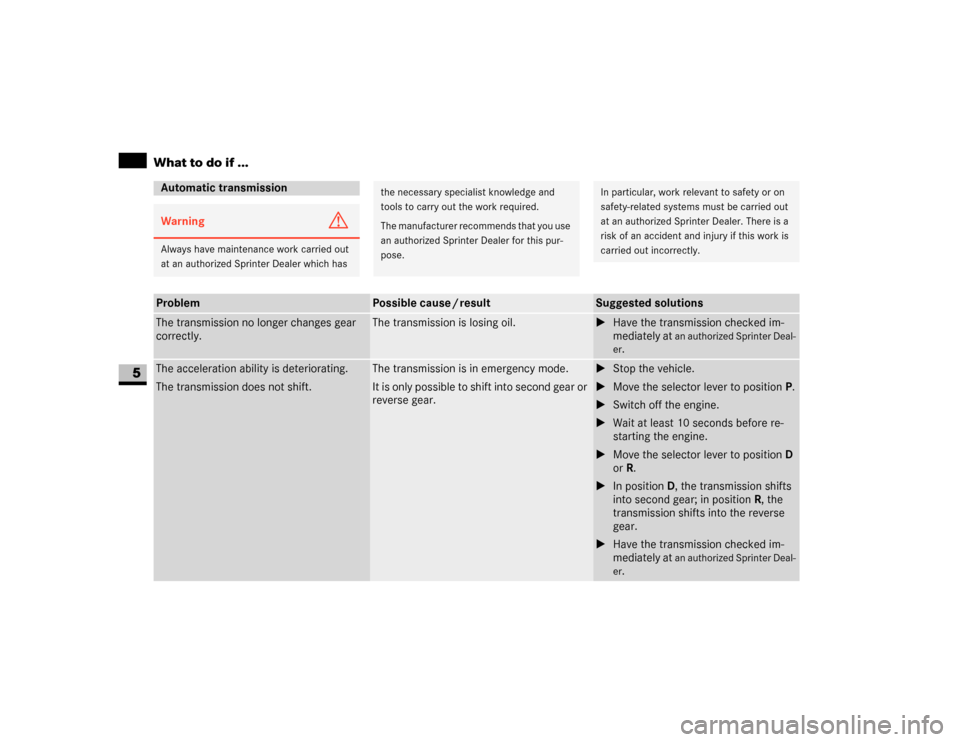
256 Practical hintsWhat to do if ...
5
Automatic transmissionWarning
G
Always have maintenance work carried out
at an authorized Sprinter Dealer which has
the necessary specialist knowledge and
tools to carry out the work required.
The manufacturer recommends that you use
an authorized Sprinter Dealer for this pur-
pose.
In particular, work relevant to safety or on
safety-related systems must be carried out
at an authorized Sprinter Dealer. There is a
risk of an accident and injury if this work is
carried out incorrectly.
Problem
Possible cause / result
Suggested solutions
The transmission no longer changes gear
correctly.
The transmission is losing oil.
\1Have the transmission checked im-
mediately at
an authorized Sprinter Deal-
er
.
The acceleration ability is deteriorating.
The transmission does not shift.
The transmission is in emergency mode.
It is only possible to shift into second gear or
reverse gear.
\1Stop the vehicle.
\1Move the selector lever to positionP.
\1Switch off the engine.
\1Wait at least 10 seconds before re-
starting the engine.
\1Move the selector lever to positionD
or R.
\1In positionD, the transmission shifts
into second gear; in positionR, the
transmission shifts into the reverse
gear.
\1Have the transmission checked im-
mediately at
an authorized Sprinter Deal-
er
.
Page 274 of 393
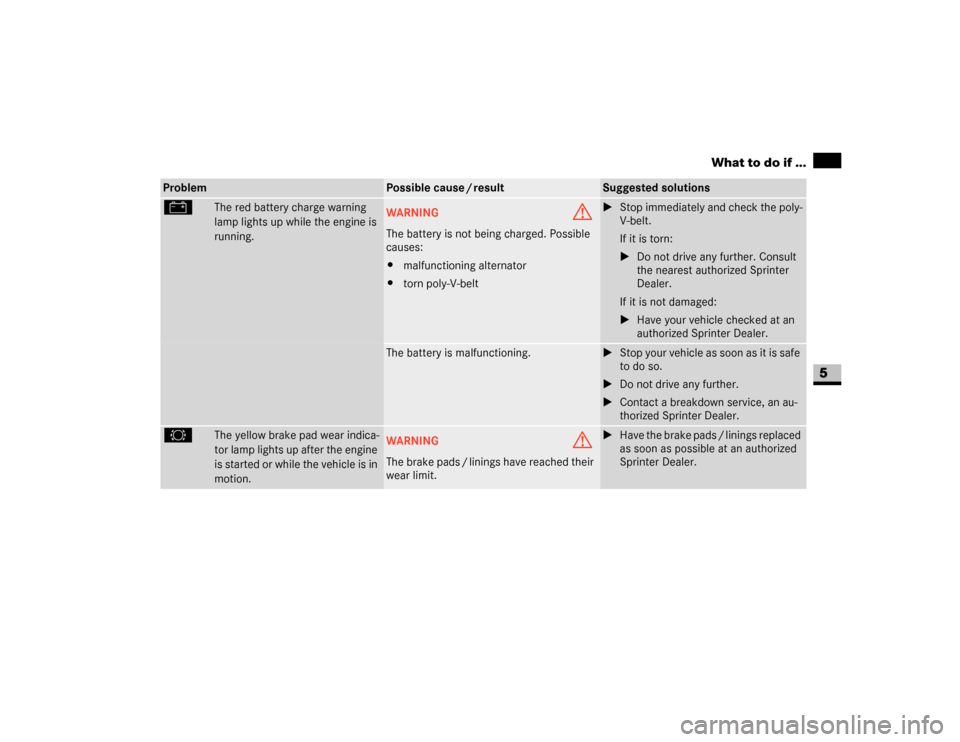
273 Practical hints
What to do if ...
5
#
The red battery charge warning
lamp lights up while the engine is
running.
WARNING
G
The battery is not being charged. Possible
causes:
\4malfunctioning alternator
\4torn poly-V-belt
\1Stop immediately and check the poly-
V-belt.
If it is torn:
\1Do not drive any further. Consult
the nearest authorized Sprinter
Dealer.
If it is not damaged:
\1Have your vehicle checked at an
authorized Sprinter Dealer.
The battery is malfunctioning.
\1Stop your vehicle as soon as it is safe
to do so.
\1Do not drive any further.
\1Contact a breakdown service, an au-
thorized Sprinter Dealer.
2
The yellow brake pad wear indica-
tor lamp lights up after the engine
is started or while the vehicle is in
motion.
WARNING
G
The brake pads / linings have reached their
wear limit.
\1Have the brake pads / linings replaced
as soon as possible at an authorized
Sprinter Dealer.
Problem
Possible cause / result
Suggested solutions
Page 275 of 393
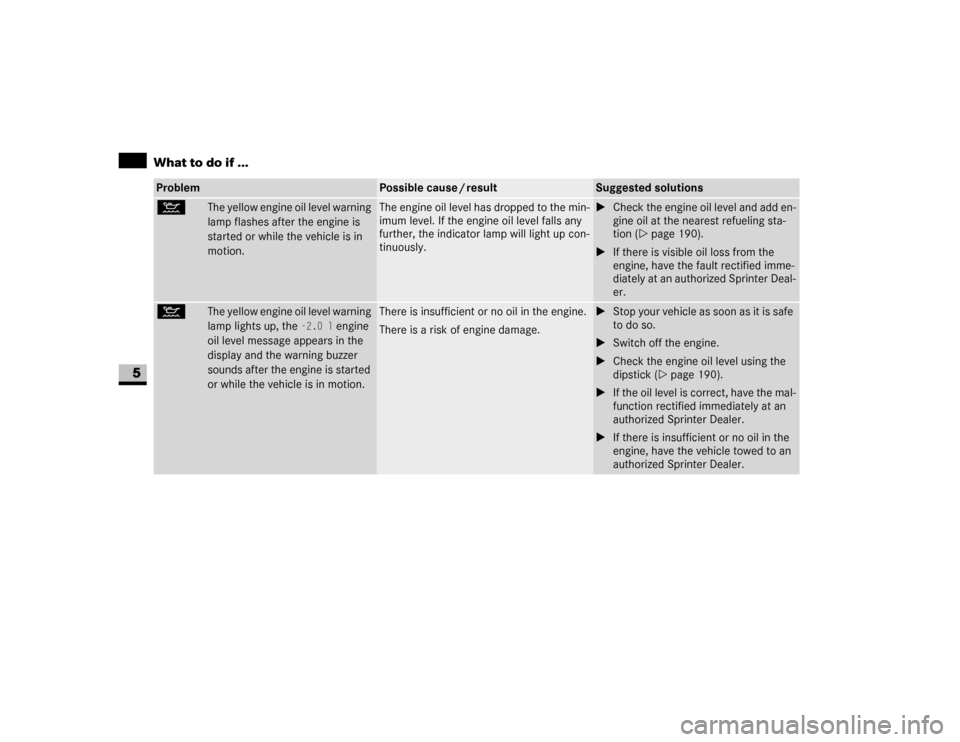
274 Practical hintsWhat to do if ...
5
:
The yellow engine oil level warning
lamp flashes after the engine is
started or while the vehicle is in
motion.
The engine oil level has dropped to the min-
imum level. If the engine oil level falls any
further, the indicator lamp will light up con-
tinuously.
\1Check the engine oil level and add en-
gine oil at the nearest refueling sta-
tion (\2page 190).
\1If there is visible oil loss from the
engine, have the fault rectified imme-
diately at an authorized Sprinter Deal-
er.
:
The yellow engine oil level warning
lamp lights up, the
-2.0 l
engine
oil level message appears in the
display and the warning buzzer
sounds after the engine is started
or while the vehicle is in motion.
There is insufficient or no oil in the engine.
There is a risk of engine damage.
\1Stop your vehicle as soon as it is safe
to do so.
\1Switch off the engine.
\1Check the engine oil level using the
dipstick (\2page 190).
\1If the oil level is correct, have the mal-
function rectified immediately at an
authorized Sprinter Dealer.
\1If there is insufficient or no oil in the
engine, have the vehicle towed to an
authorized Sprinter Dealer.
Problem
Possible cause / result
Suggested solutions
Page 276 of 393
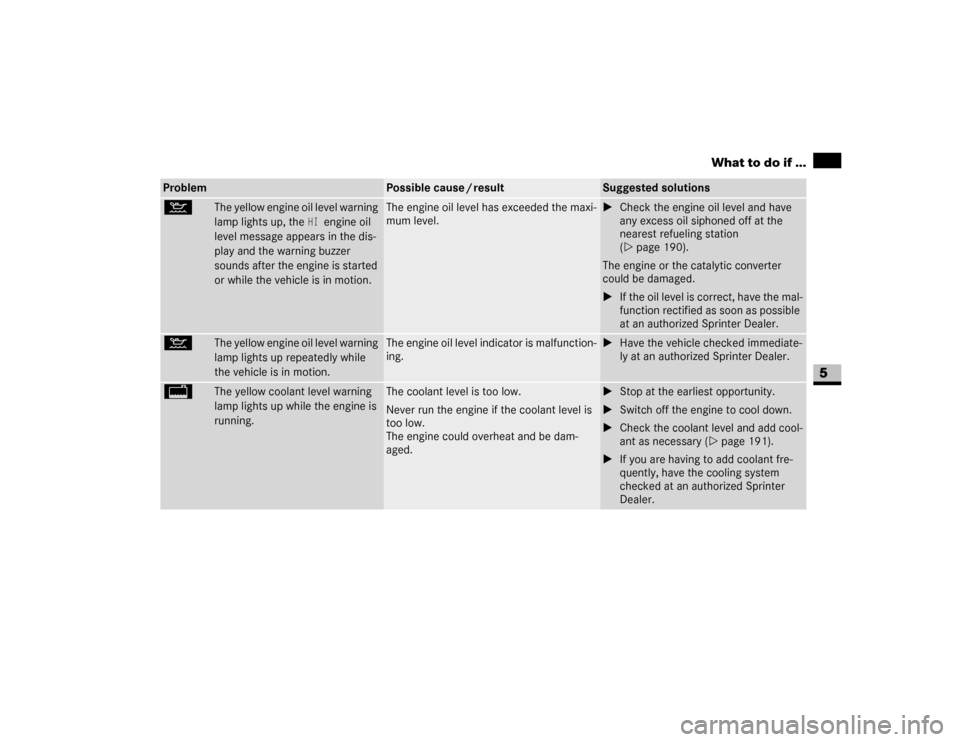
275 Practical hints
What to do if ...
5
:
The yellow engine oil level warning
lamp lights up, the
HI
engine oil
level message appears in the dis-
play and the warning buzzer
sounds after the engine is started
or while the vehicle is in motion.
The engine oil level has exceeded the maxi-
mum level.
\1Check the engine oil level and have
any excess oil siphoned off at the
nearest refueling station
(\2page 190).
The engine or the catalytic converter
could be damaged.
\1If the oil level is correct, have the mal-
function rectified as soon as possible
at an authorized Sprinter Dealer.
:
The yellow engine oil level warning
lamp lights up repeatedly while
the vehicle is in motion.
The engine oil level indicator is malfunction-
ing.
\1Have the vehicle checked immediate-
ly at an authorized Sprinter Dealer.
/
The yellow coolant level warning
lamp lights up while the engine is
running.
The coolant level is too low.
Never run the engine if the coolant level is
too low.
The engine could overheat and be dam-
aged.
\1Stop at the earliest opportunity.
\1Switch off the engine to cool down.
\1Check the coolant level and add cool-
ant as necessary (\2page 191).
\1If you are having to add coolant fre-
quently, have the cooling system
checked at an authorized Sprinter
Dealer.
Problem
Possible cause / result
Suggested solutions
Page 280 of 393
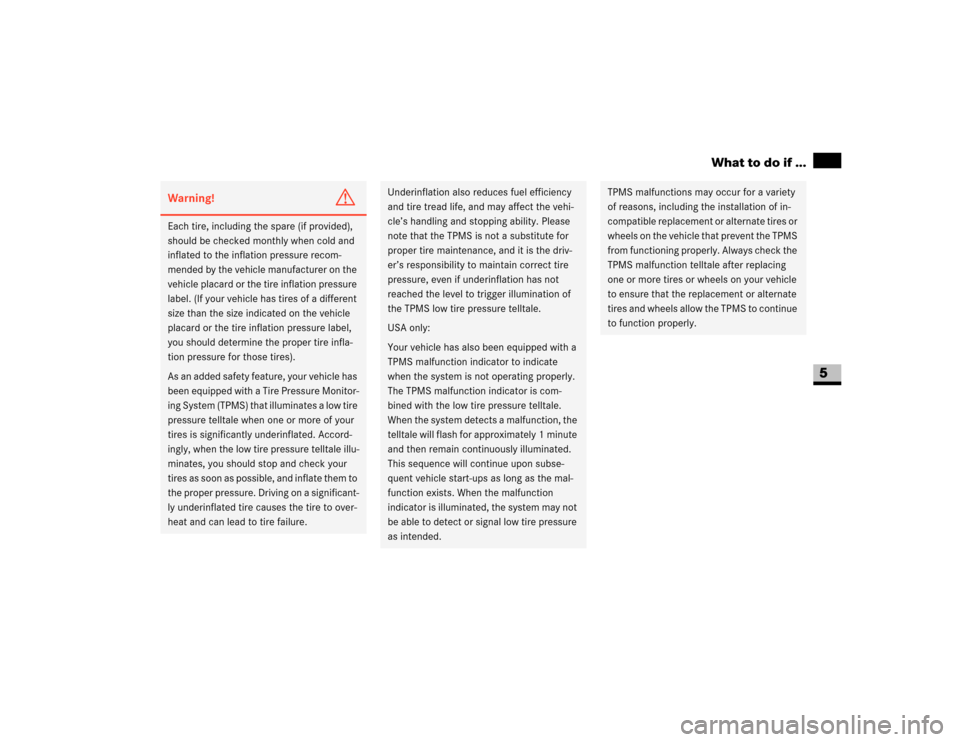
279 Practical hints
What to do if ...
5
Warning!
G
Each tire, including the spare (if provided),
should be checked monthly when cold and
inflated to the inflation pressure recom-
mended by the vehicle manufacturer on the
vehicle placard or the tire inflation pressure
label. (If your vehicle has tires of a different
size than the size indicated on the vehicle
placard or the tire inflation pressure label,
you should determine the proper tire infla-
tion pressure for those tires).
As an added safety feature, your vehicle has
been equipped with a Tire Pressure Monitor-
ing System (TPMS) that illuminates a low tire
pressure telltale when one or more of your
tires is significantly underinflated. Accord-
ingly, when the low tire pressure telltale illu-
minates, you should stop and check your
tires as soon as possible, and inflate them to
the proper pressure. Driving on a significant-
ly underinflated tire causes the tire to over-
heat and can lead to tire failure.
Underinflation also reduces fuel efficiency
and tire tread life, and may affect the vehi-
cle’s handling and stopping ability. Please
note that the TPMS is not a substitute for
proper tire maintenance, and it is the driv-
er’s responsibility to maintain correct tire
pressure, even if underinflation has not
reached the level to trigger illumination of
the TPMS low tire pressure telltale.
USA only:
Your vehicle has also been equipped with a
TPMS malfunction indicator to indicate
when the system is not operating properly.
The TPMS malfunction indicator is com-
bined with the low tire pressure telltale.
When the system detects a malfunction, the
telltale will flash for approximately 1 minute
and then remain continuously illuminated.
This sequence will continue upon subse-
quent vehicle start-ups as long as the mal-
function exists. When the malfunction
indicator is illuminated, the system may not
be able to detect or signal low tire pressure
as intended.
TPMS malfunctions may occur for a variety
of reasons, including the installation of in-
compatible replacement or alternate tires or
wheels on the vehicle that prevent the TPMS
from functioning properly. Always check the
TPMS malfunction telltale after replacing
one or more tires or wheels on your vehicle
to ensure that the replacement or alternate
tires and wheels allow the TPMS to continue
to function properly.
Page 293 of 393
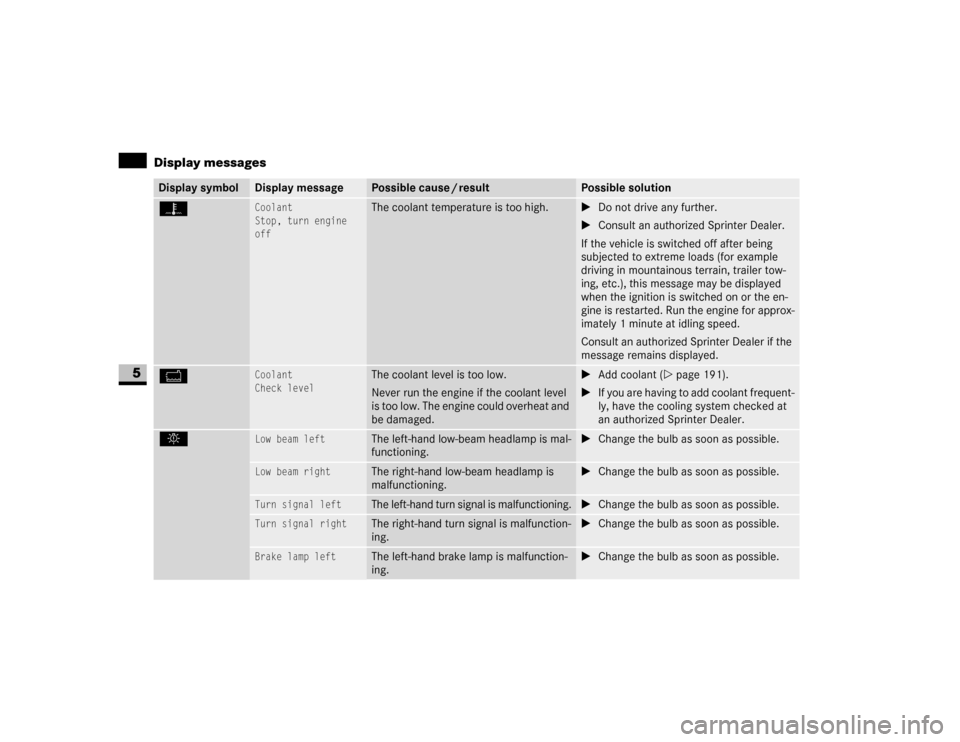
292 Practical hintsDisplay messages
5
Z
Coolant
Stop, turn engine
off
The coolant temperature is too high.
\1Do not drive any further.
\1Consult an authorized Sprinter Dealer.
If the vehicle is switched off after being
subjected to extreme loads (for example
driving in mountainous terrain, trailer tow-
ing, etc.), this message may be displayed
when the ignition is switched on or the en-
gine is restarted. Run the engine for approx-
imately 1 minute at idling speed.
Consult an authorized Sprinter Dealer if the
message remains displayed.
H
Coolant
Check level
The coolant level is too low.
Never run the engine if the coolant level
is too low. The engine could overheat and
be damaged.
\1Add coolant (\2page 191).
\1If you are having to add coolant frequent-
ly, have the cooling system checked at
an authorized Sprinter Dealer.
.
Low beam left
The left-hand low-beam headlamp is mal-
functioning.
\1Change the bulb as soon as possible.
Low beam right
The right-hand low-beam headlamp is
malfunctioning.
\1Change the bulb as soon as possible.
Turn signal left
The left-hand turn signal is malfunctioning.
\1Change the bulb as soon as possible.
Turn signal right
The right-hand turn signal is malfunction-
ing.
\1Change the bulb as soon as possible.
Brake lamp left
The left-hand brake lamp is malfunction-
ing.
\1Change the bulb as soon as possible.
Display symbol
Display message
Possible cause / result
Possible solution